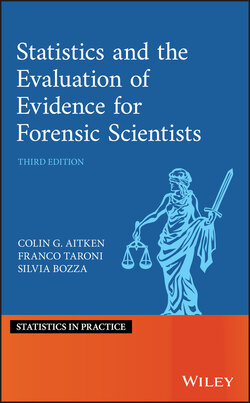Читать книгу Statistics and the Evaluation of Evidence for Forensic Scientists - Franco Taroni - Страница 43
Law of Total Probability
ОглавлениеIf are mutually exclusive and exhaustive events,
(1.12)
This is sometimes known as the extension of the conversation (Lindley 1991)
An example for blood types and paternity cases is given by Lindley (1991). Consider two possible groups, (Rh) and (Rh+) for the father, so here . Assume the relative frequencies of the two groups are and , respectively. The child is Rh (event ) and the mother is also Rh (event ). The probability of interest is the probability a Rh mother will have a Rh child, in symbols . This probability is not easily derived directly but the derivation is fairly straightforward if the law of total probability is invoked to include the father.
(1.13)
This is a generalisation of the law to include information . If both parents are Rh, event ( and ), then the child is Rh with probability 1, so . If the father is Rh+ (the mother is still Rh), event , then . Assume that parents mate at random with respect to the Rhesus quality. Then , the relative frequency of Rh in the population, independent of . Similarly, , the relative frequency of Rh+ in the population. These probabilities can now be inserted in (1.13) to obtain
for the probability that a Rh mother will have a Rh child. This result is not intuitively obvious, unless one considers the approach based on the law of total probability.
An example using DNA profiles is given in Evett and Weir (1998). According to the 1991 census, the New Zealand (NZ) population consists of 83.47% Caucasians, 12.19% Maoris, and 4.34% Pacific Islanders; denote the event that a person chosen at random from the 1991 NZ population is Caucasian, Maori, or Pacific Islander as Ca, Ma, and Pa, respectively. The probabilities of finding the same YNH24 genotype (event ) in a crime sample for a Caucasian, Maori, or Pacific Islander are 0.012, 0.045, and 0.039, respectively. These values are the assessments for the following three conditional probabilities: Then the probability of finding the YNH24 genotype, , in a person taken at random from the whole population of New Zealand is
A further extension of this law to consider probabilities for combinations of genetic marker systems in a racially heterogeneous population has been given by Walsh and Buckleton (1988). Let and be two genetic marker systems with realisations and , , and . Let and be two mutually exclusive and exhaustive subpopulations such that a person from the population belongs to one and only one of and . Let and be the probabilities that a person chosen at random from the population belongs to and to , respectively. Then . Within each subpopulation and are independent so that the probability an individual chosen at random from one of these subpopulations is of type is simply the product of the individual probabilities. Thus
However, such a so‐called conditional independence result does not imply unconditional independence (i.e. that ). The probability that an individual chosen at random from the population is , without regard to his subpopulation membership, may be written as follows
This is not necessarily equal to as is illustrated in the following example. Let , and Then
The product of and is not necessarily equal to . Suppose, for example that , and . Then
